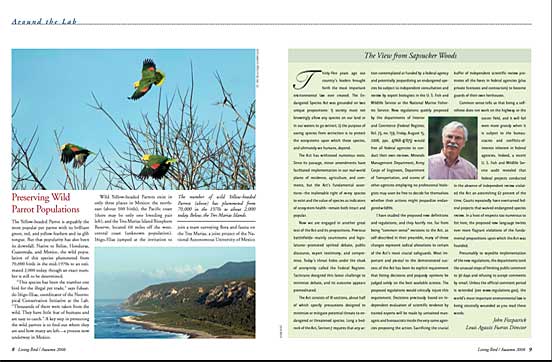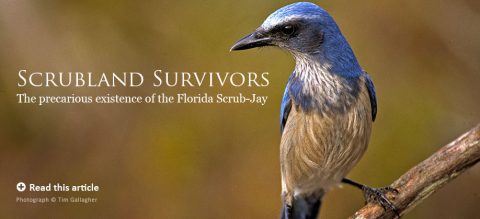View From Sapsucker Woods: 35 Years of the Endangered Species Act
By John Fitzpatrick October 15, 2008
Thirty-five years ago our country’s leaders brought forth the most important environmental law ever created. The Endangered Species Act was grounded on two unique propositions: 1) society must not knowingly allow any species on our land or in our waters to go extinct; 2) the purpose of saving species from extinction is to protect the ecosystems upon which these species, and ultimately we humans, depend.
The Act has withstood numerous tests. Since its passage, minor amendments have facilitated implementation in our real-world places of residence, agriculture, and commerce, but the Act’s fundamental assertions—the inalienable right of every species to exist and the value of species as indicators of ecosystem health—remain both intact and popular.
Now we are engaged in another great test of the Act and its propositions. Previous battlefields—mainly courtrooms and legislatures—promoted spirited debate, public discourse, expert testimony, and compromise. Today’s threat hides under the cloak of anonymity called the Federal Register. Tacticians designed this latest challenge to minimize debate, and its outcome appears premeditated.
The Act consists of 18 sections, about half of which specify precautions designed to minimize or mitigate potential threats to endangered or threatened species. Long a bedrock of the Act, Section 7 requires that any action contemplated or funded by a federal agency and potentially jeopardizing an endangered species be subject to independent consultation and review by expert biologists in the U. S. Fish and Wildlife Service or the National Marine Fisheries Service. New regulations quietly proposed by the departments of Interior and Commerce (Federal Register, Vol. 73, no. 159, Friday, August 15, 2008, pps. 47868-47875) would free all federal agencies to conduct their own reviews. Minerals Management Department, Army Corps of Engineers, Department of Transportation, and scores of other agencies employing no professional biologists may soon be free to decide for themselves whether their actions might jeopardize endangered wildlife.
I have studied the proposed new definitions and regulations, and they horrify me. Far from being “common sense” revisions to the Act, as self-described in their preamble, many of these changes represent radical alterations to certain of the Act’s most crucial safeguards. Most important and pivotal to the demonstrated success of the Act has been its explicit requirement that listing decisions and jeopardy opinions be judged solely on the best available science. The proposed regulations would critically injure this requirement. Decisions previously based on independent evaluation of scientific evidence by trained experts will be made by untrained managers and bureaucrats inside the very same agencies proposing the action. Sacrificing the crucial buffer of independent scientific review promotes all the foxes in federal agencies (plus private licensees and contractors) to become guards of their own henhouses.
Common sense tells us that being a self-referee does not work on the highway or the soccer field, and it will fail even more grossly when it is subject to the bureaucracies and conflicts-of-interest inherent in federal agencies. Indeed, a recent U. S. Fish and Wildlife Service audit revealed that federal projects conducted in the absence of independent review violated the Act an astonishing 62 percent of the time. Courts repeatedly have overturned federal projects that waived endangered species review. In a host of respects too numerous to list here, the proposed new language invites ever more flagrant violations of the fundamental propositions upon which the Act was founded.
Presumably to expedite implementation of the new regulations, the departments took the unusual steps of limiting public comment to 30 days and refusing to accept comments by email. Unless the official comment period is extended (see www.regulations.gov), the world’s most important environmental law is being viscerally wounded as you read these words.
John Fitzpatrick
Louis Agassiz Fuertes Director

All About Birds
is a free resource
Available for everyone,
funded by donors like you
American Kestrel by Blair Dudeck / Macaulay Library



